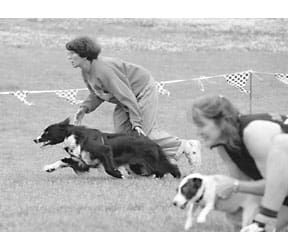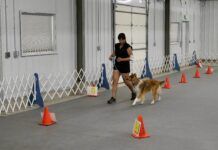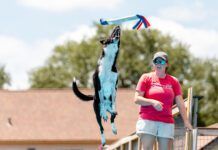[Updated February 7, 2019]
Picture this: Two racing lanes, each with a row of four jumps leading up to mechanized boxes that throw tennis balls. Now imagine two teams, each with four ball-crazed dogs. The dogs are wound so tight that they can barely contain themselves. Their excited barking reaches a deafening pitch.
Suddenly, a light flashes green and the dogs are off. The first two dogs on each team race down their row of jumps and, with seemingly effortless motion, each dog banks off the box, hitting a pedal that shoots out the ball. If you blink, you’ll miss the ball catch as the dogs race each other back over the jumps. As the first two dogs cross the finish line, the next dogs on each team take off, passing at full speed. In less than 20 seconds, all four dogs on both teams have run the course, with the winning team crossing the finish only a split second ahead.
Tom Schaefges
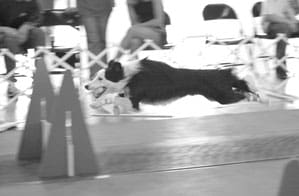
Flyball racing is fast and furious. Most of all, it’s a great time for both dogs and people!
“The first time I saw Flyball, I laughed so hard that tears were streaming down my face,” said Jackie Earnshaw, Flyball enthusiast and owner of Sit Spot Dog Training in Boulder Creek, California. Earnshaw knew she liked Flyball from the start. “It was sheer joy, watching the dogs have such a good time.”
Lonnie Olson, author of Flyball Racing: The Dog Sport for Everyone, and founder of Dog Scouts of America, also got involved in Flyball racing because it looked like a fun thing to do with dogs. “Flyball offered fun, friendly, team competition, as an alternative to obedience competition – which was the only dog sport in popularity back in the early 80s.”
What is Flyball Racing?
“Dogs who like to play Flyball don’t just simply like it, they love it!” says Earnshaw, who is teaching Flyball to her Rottweiler, J.B., and recently founded a new Flyball group called the Box Rockers. With group and team names like Ballistics, Mighty Mutts, Box Rockers, Tail Spinners, and Rude Dogs, you know this sport is about honoring a dog’s true nature – to run, play, and have a blast.
Flyball is an obvious choice for ball-crazed dogs, but even if your dog is not into retrieving, he can be taught to hit the pedal, grab the ball, and race back to you.
“Some dogs who are not natural retrievers learn to retrieve, and then become ball crazed,” says Olson, who advocates teaching dogs to retrieve using clicker training and backward chaining. “The whole idea is that even if your dog doesn’t like the ball, he will gleefully retrieve to get the reward you are offering.” Olson teaches Flyball seminars and offers Flyball training at the Dog Scouts of America summer camps. She lives with three Border Collies, a mixed breed that looks like a Karelian Bear Dog, and a cattle dog (her husband’s dog) – all of whom enjoy Flyball.
But what if you have a dog who is too ball crazy? Flyball training is also a good opportunity to work with dogs with ball “issues.” For example, you can teach dogs who like to play keep away with retrieve objects to reliably bring the ball back. And for dogs that are out-of-control retrievers, Flyball is a good avenue to channel their drive, while helping them learn self-control.
Plus there’s the exercise factor. We’ve all heard the saying that, “A tired dog is a good dog.” Flyball works dogs hard, which may be part of why it appeals to both high-energy dogs and their human roommates. “It’s a wonderful energy burner,” says Earnshaw. “It gives the dogs a lot of exercise in a short amount of time, without a huge physical drain on the person.”
Any Dog Can Play Flyball
Flyball racing is open to any breed and any size dog. While speed-demon dogs like Border Collies and Jack Russell Terriers are obvious contenders for Flyball, they are not the only dogs that will enjoy and excel at the sport. According to the North American Flyball Association (NAFA, the organization that oversees tournaments in North America), there are more than 170 different breeds (including mixed breeds) registered to race in Flyball tournaments. In fact, NAFA’s top pointed dog for 2001 was a mixed breed.
Tom Schaefges

Long-legged dogs definitely offer a speed advantage, but smaller dogs, such as small mixed breeds or terriers, fulfill very important roles on a team. Since the smallest dog on the team determines the height of the jumps for the entire team, many teams include one small speedster to augment their speedy strategy. Don’t worry; a small dog doesn’t have to force a standard size tennis ball into his tiny mouth – in Flyball, smaller sized balls can be used if those are more comfortable for the dog.
Any dog that is physically able to run, jump, and bank off the box is a good candidate for Flyball. In addition, because dogs run in close proximity to other dogs – while in a highly aroused state – they must not display aggression toward other dogs.
Dog Skills for Flyball: Speed and More Speed
A Flyball course is 51 feet long with four jumps, spaced at 10-foot intervals. The first jump is placed 6 feet after the start/finish line, and the Flyball box is placed 15 feet after the fourth jump. The jump height is set at 4 inches lower than the smallest dog, with the minimum height being 8 inches and the maximum being 16 inches.
Each dog must run in relay fashion down the jumps, trigger the release of the ball, catch the ball, and then run back over the four jumps. The next dog is released to run the course, but can’t cross the start/finish line until the previous dog has returned and crossed the line. If a dog loses the ball or misses a jump, he must run again after the rest of the team has completed their turn. The first team to have all four dogs finish without errors wins.
Flyball is obviously about speed – and competitions are won and lost with fractions of seconds. But that doesn’t mean your dog (or your team) has to be the fastest of the fast to enjoy competition. In NAFA sanctioned tournaments, teams are divided into divisions so that they compete against other teams of equal abilities. That way every team has a chance at winning an individual race.
Dogs who run Flyball can earn points toward Flyball titles. To earn points, the team must complete the race within a certain amount of time (you don’t have to win to earn points, only complete the race). If a team’s race time is less than 32 seconds, each dog on a team will earn one point. If a team’s race time is less than 28 seconds, each dog earns five points. If a team’s race time is under 24 seconds, each dog earns 25 points. Titles are awarded for 20 points, 100 points, 500 points, 5,000 points, 10,000 points, 15,000 points, 20,000 points, and 30,000 points.
Sometimes, competitions are run for exhibition purposes only, without the team earning points toward a title. In addition, as with Agility and other dog sports, there is a current trend among some Flyball enthusiasts to promote a more casual or “for fun” avenue of the sport. In fact, Earnshaw founded the Box Rockers about a year ago because she was interested in having a group that focused more on getting together and having fun than on competition.
Flyball Fundamentals
Flyball racing seems straightforward – dogs run down the course, get the ball, and run back. But Flyball racing is actually a series of over 25 different behaviors put together. For a dog to run a course with speed and accuracy, each of the elements or behaviors needs to be carefully taught.
“I’ve seen dogs ‘get it’ (the basics) in one night of training,” says Olson when asked how long it takes to train a dog for Flyball. “However, that’s not the best way to train. I use a very systemized method, involving backward chaining, which makes the finished product much more flawless. There’s more to it than just learning to jump and learning to press a pedal and get a ball. Everyone should work at their own dog’s speed, and not be in a hurry to get to the finished product.”
Earnshaw also emphasizes a systematic approach to training dogs in Flyball. “It’s very important not to rush the dog,” says Earnshaw. “Laying a solid foundation from the start is very important.”
Some of the behaviors dogs need to learn include snatching the ball in the air, turning quickly, and returning to you. They need to understand single bounce jumping so they can run with maximum speed. They need to be able to push the pedal on the box, and then to catch the ball as it shoots out. They need to master turning off the box (called a swimmer’s turn) and be able to pass other dogs at full speed. When the dogs have these and other behaviors down, they need to learn to put it all together into a run.
Tom Schaefges
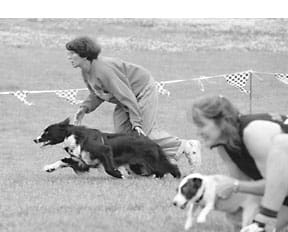
Olson considers passing the most exciting part of Flyball. “It is the thing that possibly the uneducated spectators notice the least, but is the biggest part of the sport,” says Olson. “Much work goes into creating precision passes.” The pass is, simply put, the part of the course where one dog crosses the finish line as the next dog on the team begins his run. The two dogs pass each other, often within inches at full speed and without losing concentration or speed. “The pass (or exchange, as they call it in Canada) will win or lose the race for a team. There’s only one thing more exciting for a Flyball enthusiast watching a race than seeing a tight pass, and that’s seeing a close finish!”
Olson and Earnshaw both stress that the best way to teach Flyball skills is through positive, motivational methods. For example, clicker training can be used to shape a dog to push the pedal on the box. Backward chaining – teaching the dog the last part of exercise first – is very effective in Flyball. With backward chaining, the dog learns that ultimately his reward comes when he finishes the course.
Finding Flyball
Flyball is a fast growing dog sport with teams and groups popping up in many areas. But as fast as it’s growing, Flyball is still relatively new and it’s sometimes difficult to find a group to train with. “You may have to look hard to find Flyball,” warns Earnshaw. She also points out that when you find a group, make sure that you are comfortable and that the group offers what you want for your dog.
Olson agrees. “Remember that this is a game. Find a group that uses a behavioral approach to training. But, most importantly, find a group of warm, friendly people that you can relate to. Your fellow team members are going to become like family. You should choose people who are fun, friendly, and fair.”
If you can’t find a group in your area, you can follow Earnshaw’s example and start your own. Olson’s book may also help you get started. Flyball Racing: The Dog Sport for Everyone, offers great tips on building equipment, training the dogs, putting together a team, and getting involved in competition.
When asked what she would tell someone who was interested in giving Flyball a try, Earnshaw responded enthusiastically, “Do it! It’s great fun for the dogs and hilarious for the people.”
And, if you’re not sure you want to try it with your dog, you may still want to find a Flyball tournament to watch. “Flyball is my favorite spectator sport,” says Olson. “You can keep your baseball and your drag racing. For me, I get excited just thinking about going to a Flyball competition!”
Here are some more resources for finding and playing flyball:
flyballdogs.com. This excellent Web site has everything you might want to know about Flyball, including information on training, equipment, finding a team near you, and more. Also, this is the place to get information about joining the Flyball e-mail list.
flyball.org. This is the Web site of the North American Flyball Association. You can learn more about the organization, get the latest points and tournament results or download a copy of the NAFA Rules.
Flyball Racing: The Dog Sport for Everyone, by Lonnie Olson. This book provides an excellent introduction to the sport of Flyball with information on building equipment and extensive training tips.
A Brief History of Flyball
Flyball was invented in the late 1970s. Rumor has it that a man named Herbert Wagner first showed Flyball on Johnny Carson’s The Tonight Show and that shortly thereafter, trainers and dog clubs from around the country were building Flyball boxes. The sport quickly grew in popularity and in 1985, the North American Flyball Association (NAFA) was formed by a group of 12 teams from Michigan and Ontario. NAFA standardized the rules, kept records of tournaments, and guided the development of Flyball racing. Flyball is now played throughout North America, Europe, Australia, and other countries. According to Brett Williams, chairman of NAFA, it is still the only governing body for the sport of Flyball in North America.
Lonnie Olson, one of the early board members of NAFA, says the sport of Flyball has changed dramatically over the years. According to Olson, Flyball got its name because it involves a mechanical box that throws out a ball for a dog to catch. In the original Flyball, the ball flew up high in the air. The dog would wait for the ball to come down, like an outfielder in baseball waits to catch a fly ball. As the dogs became more intense about the game, they began trying to catch the ball on its way up, instead of waiting for the ball to come back down. This, as you can imagine, became dangerous for the dogs. Olson said that some dogs began bashing their teeth on the “cup” that threw the ball. Flyball boxes started changing dramatically at that point, to create greater safety for the dogs. Today, most of the boxes do not have an exposed throwing arm. The ball is propelled out of a hole in the front of the box, and most dogs “catch” it before it sees daylight!
The technology for timing the races has also changed, says Olson. Historically, judges would time, officiate, and determine the outcomes of races. While judges still officiate, electronic timing systems are usually used in tournaments today. The timing systems not only time the races, but also detect infractions and signal (with red lights) infractions made by false starts or premature passes during racing. Because of changes in the box and other technology, the winning times for Flyball dogs have decreased. Back in 1985, Olson’s team was declared the “Flyball Champions” with a best time of 32 seconds. Today, many teams run the course in less than 20 seconds.
Flyball grows in popularity with every competition and public exhibition. Today, NAFA has more than 300 member clubs with more than 7,000 registered dogs.
Mardi Richmond is a freelance writer who lives in Santa Cruz, California. Richmond and her dog, Blue, are just learning the sport of Flyball, but they’ve already realized that it may offer the most fun a ball-driven dog can have. Mardi also teaches Just for Fun Agility classes and is the co-author of Ruffing It: The Complete Guide to Camping with Dogs.



